What Would You Save from a Burning Museum? Thoughts Upon Reading “The Goldfinch”
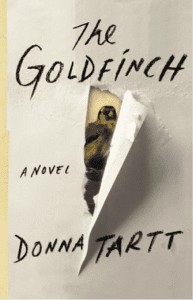
In the book, a terrorist bomb explodes at The Metropolitan Museum of Art when the The Goldfinch is there on
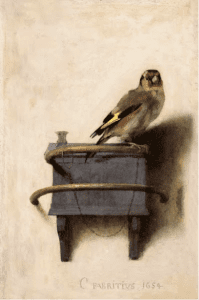
Carel Fabritius, The Goldfinch, 1654 (The Hague, Maritshuis)
exhibition. In the confusion, Theo Decker, the main character, stumbles out of the museum with the painting, and spends the rest of the novel trying to figure out how to return it without further destroying his life. But the longer it remains in his possession, the more it becomes the object that defines him, that gives him both pain and purpose.
As I read The Goldfinch, I couldn’t help but wonder, if I were in a similar situation and could remove one work of art from a museum under attack, what would I save? And further, what object in my possession is so meaningful to me that it has a personal value that transcends its own monetary worth? What object, if it were destroyed or somehow lost to me, would I think of with regret for the rest of my life?
I think about the first question in terms of what object I repeatedly revisit, what object I insist that others see, when they accompany me to the museum I visit the most often, which as it turns out, is also The Metropolitan Museum of Art. Surprisingly, it is not in the medieval galleries, but rather upstairs, in the first room of the newly-reinstalled European Paintings wing.
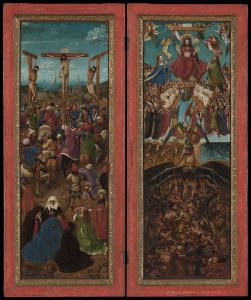
Jan van Eyck, Crucifixion/Last Judgment, 1435-40 (New York, The Metropolitan Museum of Art)
There, in pride of place in the very center of the room, resides the diminutive diptych by Jan van Eyck of the Crucifixion and Last Judgment. In this tiny work of art, there is so much to absorb. The rush from the foreground into the mountainous landscape in the background leaves me breathless. The incredible detail is so precise that some of the minute brushstrokes must have been made with “two hairs and some air,” as the late great Bob Ross of the DIY TV show “The Joy of Painting” used to say. The artist took extraordinary care in the creation of the figures who mill about the base of Christ’s cross, with certain people drawing particular attention – is that the donor/owner in the large blue hat, the only one who looks out at us (or perhaps himself)? Who is reflected in the copper helmet hanging from the belt of the figure in mauve? And then, on the right-hand panel, the better-than-Bosch depiction of hell in all its monstrosity, with the souls of the damned extruded into hell through the bones of a grinning spread-eagled skeleton, and a fashion-plate St. Michael with his peacock wings serenely waving them down. Above, Christ sits as impassive judge with his cordial group of saints, (probably painted by someone else — Rogier van der Weyden?), waiting to determine the fate of the souls of the dead rising out of the land and sea.
That’s the painting I would grab if the Met were on fire. And if we’re not thinking about the practicalities, I would
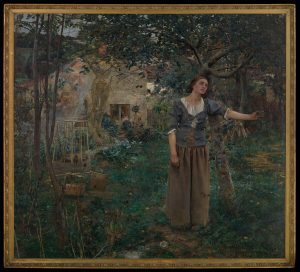
Jules Bastien-Lepage, Joan of Arc, 1879 (New York, The Metropolitan Museum of Art)
run very fast down the hallway and grab the gigantic Bastien-Lepage Joan of Arc. THAT is my favorite painting in the Met, and I don’t think I’ve ever been in the building without trying to stop by to pay homage, even for a brief moment. I love Joan of Arc. Joan of Arc is part of the reason I am a medievalist. And this particular painting is everything I love about the nineteenth-century appropriation of the Middle Ages, in all its fanciful romanticization of the past.
In Tartt’s novel, the painting of The Goldfinch spends more time in the possession of the main character than it does at the Met. It becomes his painting, even though he’s constantly tormented by it. It is his burden and his blessing; the object of his greatest anxiety, but also the one constant in his tumultuous existence. It becomes a holy relic of the museum, as well as a symbol of enduring beauty in a life filled with unfortunate choices and wasted opportunities. So the other question I was left with was about what things in my own possession have this kind of hold on my soul, that speak to some deep-rooted part of me. There are probably a number of things that I could select, but certainly one would be the hand-colored photograph by Wallace Nutting that hung in my paternal grandparents’ house, and then in my own bedroom when I was a child.
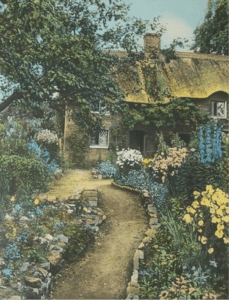
Wallace Nutting, A Garden of Larkspur, 1914
It is not particularly valuable; Nutting and the group of young women he hired to color his photographs produced thousands of these images, and there are any number of them floating around on eBay. But I used to envision myself in this scene, walking up the path through the perfect country garden, to peer into the diamond-paned windows and enter into the charmingly dilapidated cottage. Nutting was from Massachusetts and primarily photographed New England locations, but I always imagined that this scene was somewhere in long-ago, fairy-tale England, and I invented complicated and romantic narratives involving girls in long white dresses wandering through the garden of larkspur. The photograph is still in my parents’ home, and it has been promised to me. It is the one thing that I really want.
One family possession has been lost to me, and I’ve spent years trying to find something similar. My maternal grandparents had a Niagara Falls motion lamp. The heat of the light bulb made one cylinder rotate inside the other, giving the impression that water was actually flowing over the falls.
For a young girl, it was the coolest thing ever. Within a few years of my grandfather’s untimely death, the house was broken up and the lamp was sold, or perhaps even tossed; most family members found it kitsch at best. Motion lamps are highly collectible now, but I’ve never come across one that is as beautiful as the one owned by my grandparents, or at least none that are as wonderful as the one that exists in my memory.
What will my own children want out of our house, when the time comes? Without a doubt, the painting of Santa Claus, done by my husband’s aunt, an enthusiastic amateur painter. When it emerges from storage in mid-December and we hang it over the fireplace, in the room with the sparkling Christmas tree, we know that the holidays, with all their magic, are truly here.
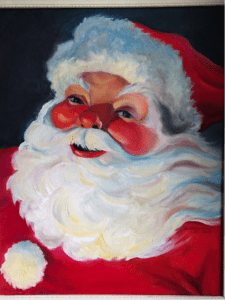
Betty Wieder, The Night Before Christmas, 2000
None of these personal possessions have any particular value in the marketplace. But they are precious all the same, their worth derived from their relationships with the people who love them.
In the very last pages of the novel The Goldfinch, Theo (or really the author) makes some grand philosophical pronouncements about truth and illusion, about love and death. And there are some thoughts about the painting of The Goldfinch itself: “…the painting has taught me that we can speak to each other across time…[i]t exists; and it keeps on existing. And I add my own love to the history of people who have loved beautiful things, and looked out for them, and pulled them from the fire, and sought them when they were lost, and tried to preserve them and save them while passing them along literally from hand to hand, singing out brilliantly from the wreck of time to the next generation of lovers, and the next.” As sweepingly grandiose as this language is, it seems to me that in effect this is what art historians do – we understand that objects can be the vehicles that “speak across time,” that connect us to the past, and by studying and teaching them, we pass them on to the next generation. In a time when art and architecture are deliberately targeted and destroyed for political and religious ends, the urgency to save and preserve the objects that mean so much to people seems all too terribly real.: http://www.independent.co.uk/news/science/archaeology/news/the-destruction-of-the-idols-syrias-patrimony-at-risk-from-extremists-9122275.html
I do wonder what other people would save from a burning museum. And I’m also interested in objects that are personally meaningful. I call for a history of loved objects, not just important objects, the things that transcend their material fetters to lodge in our hearts. What are those things for you?
